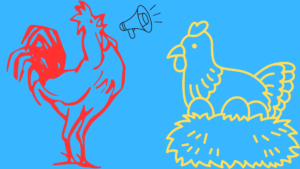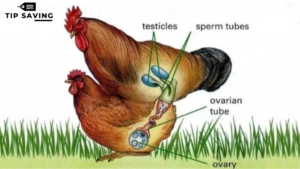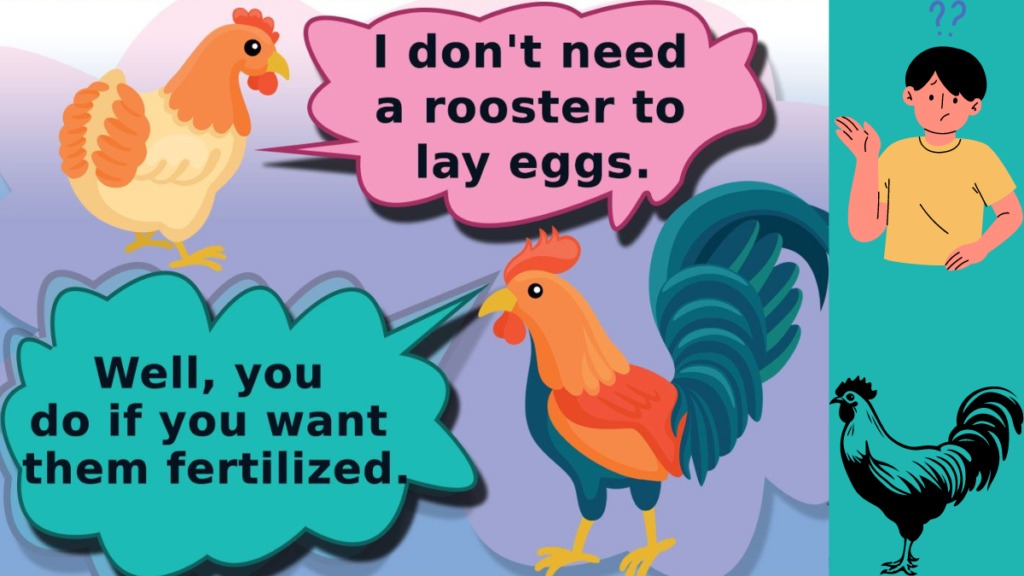Around calm turning points within rural landscapes, small towns, and hectic poultry farms everywhere – there is the same ballet playing day after day without many of us witnessing it. This dance that plays is essential for the longevity of life. This is the dance of fertilization where nature’s rooster plays a major role in the process of creation of new life. We all know that you don’t have to have a rooster to get an egg, do you? Our hens will lay eggs every day whether the male is present or not. Still, if you want to have fertilized chicken eggs, you will need a rooster to do his business with your hens and he will do it over and over again happily.
Let us now step into the complex dynamics of this process and experience the wonders of how a rooster fertilizes an egg.
The Prelude: The Rooster’s call

At dawn, when the world begins to wake up, the cock crows all over the countryside. This is not just a declaration of a new day but it’s a cry for a vigorous and fertile life. Inside the rooster’s chest is the heart of a guardian of bloodline, prepared to start his daily duty. Roosters are instilled with a genetic mandate to ensure that the Earth is populated by his brood, and he is equally serious about fulfilling it.
The Courting Ritual: Nature’s Dance
Whether in the green envelope of the barnyard or the wide stretch of the range, the rooster walks with a sense of direction. The colorful feathers reflect the sunlight, and thus it proves that he is lively. Observing from afar, he scans his crowd, choosing his dance partners carefully.
As he gets closer to a hen, his manner changes. He woos her with soft clucks and a confident dance, assuming the role of her protector and provider. If she’s attentive, she’ll give him some very weak signals, urging him to continue.
Breeding, mating, and rearing young ones start in the spring. The increase in daylight stimulates hormones, and the increase in hormones stimulates procreative behaviors. the pineal gland in the brain of the chicken feels the rise in light and this goes to the cause of the production of androgen, estrogen, and progesterone – the hormones that are responsible for the development of egg production and broodiness.
The Act of Fertilization – Secrets of Nature Ballet
In a perfect moment for mating, the rooster exhibits agility and skill in presenting himself to the hen. Through careful practice he aligns himself, their cloacas matching each other in the subtle harmony. During this “cloacal kiss”, the hen must open up her cloaca so that his sperm can reach the unlaid/unborn eggs in her oviduct. After he emits his sperm, they go back to normal. The sperm that he discharged on that day will fertilize her eggs and some of the days that followed. It is a transitory – but important – moment when sperm moves from the rooster to the hen and fertilizes the waiting egg that is within her reproductive tract.
The Miracle Unfolds: Life Takes Root
Once fertilized, the egg embarks on a transformative journey. Within its fragile shell, the development of life starts. The sperm from the rooster is deposited in the hen’s cloacal region and then migrates upward into the vagina where it can rest in the ‘pockets’ on the wall. Sperm is vital for up to 7-10 days in pockets, unless fresh is always good.
Nevertheless, sperm that have the intention to fertilize climb up to the infundibulum. The hen’s oviduct is roughly 30 inches long, and the brave sperm travels about 29 inches to reach the infundibulum and deliver the genetic code to the germinal disc of the egg.
The introduction of rooster DNA to hen DNA in the germinal disc leads to the fusion of the two and yields a zygote (fertilized seed) It takes 5 hours for the cells to divide and it is then called a blastoderm or an embryo.
Cell division and expansion proceed in the now-fertilized egg as it goes through all the phases required to form an egg. This involves laying down the albumin, building a shell, and putting bloom before the eggs lay. The embryo grows, feeding on the yolk and albumen that surrounds it. Over time, the chick develops, forming within the confines of the shell. If our hen is inclined to become a mother, she starts hunting for a suitable nest. It can be a raised platform a bush or a dark corner of the hen house. Once there is a sufficient number of eggs collected, she will start caching them.
What number in a cache is flexible, but you should be sure that she can cover them all? The number 5 to 8 is a reasonable one. If she has too many, take some out and put in another hen or an incubator.
Nurturing Life: The Journey of Development and Brooding
If you let them hatch on their own, you can take a few steps to ensure the process goes smoothly. Firstly, see that the rooster does not injure her during mating – trim the spurs and talons; put on a hen saddle if necessary.
Furthermore, when she is searching for a place to perch that is dark and concealed, attempts to entice her to a smaller, more separate area, away from the other birds. Put in a feeder and a waterer and then she would have her own ‘studio.’ Then leave her alone and she would be fine. Of course, the area should be fully secured and locked down at night for safety.

As soon as our hen determines that she has enough eggs under her, she will start brooding. This means she will stay on those eggs for the next twenty-one days until they hatch or die. She will drive the rooster away if he approaches her for mating at this time. When she becomes fully broody, the rooster won’t bother her anymore. He may be a Mr. Nice Guy and sit on her eggs for a while, but most roosters are not. His involvement with the chicks will start once they hatch. Our broody hen will carefully turn, warm, and pamper her eggs for the next 21 days. Then, she will spend little time away from the nest.
You may sometimes see her run outside to poop, dust bathe a bit and then run back to the nest and she rearranges the eggs and sits on them again which shows her commitment!
Cracking Open Life’s Potential: The Miracle of Hatching
When hatching, Mama will protect her little chicks. But a mother hen with her chicks will be left alone by all; for when any such attempt is made, she will make the assailant regret it. They will get all they need to know from her, and if the rooster is ‘family man,’ he, too, will take turns watching after his chicks.
The Cycle Continues: Nature’s Everlasting Beat
With each sun setting, a new episode of fertilization takes place, an unending cycle inscribed in the texture of being. Every crow of the rooster, every melancholy cluck of the hen awakens a new life, transmitting the heritage of previous generations.
In the backwaters of rural lands and in the most crowded poultry farms, where fertilization happens, the beauty of nature reiterates itself on and on. In this light, the next time you hear a rooster proudly strut his stuff or witness a hen delicately courted, do marvel at the magic of life and ponder the role of nature’s rooster in the delicate dance of fertilization.
Frequently Asked Questions?
Q: How do you know if a chicken egg is fertilized?
A: Determining whether a chicken egg is fertilized can be challenging without specialized equipment or incubation. However, there are a few methods you can use to get an idea. One way is called candling, which involves shining a bright light through the egg in a dark room. If the egg is fertilized, you may see a network of blood vessels developing inside the egg. Another method is to crack the egg open and examine the yolk. If the yolk has a small white spot on it, known as the blastodisc or “bull’s eye,” it indicates that the egg was fertilized. Keep in mind that these methods are not foolproof, and it’s best to consult with a poultry expert or use proper incubation techniques for accurate results.
Q: Does a hen have to mate with a rooster to lay eggs?
A: No, a hen does not need to mate with a rooster to lay eggs. Hens will naturally produce eggs as part of their reproductive cycle, regardless of whether they have mated. However, for an egg to be fertilized and develop into a chick, mating between a rooster and a hen is required. If a hen has been kept without access to a rooster, the eggs she lays will be unfertilized and will not develop into chicks.
Q: Are the eggs we eat fertilized?
A: In most cases, the eggs we consume are not fertilized. The eggs that are commonly found in grocery stores and used for human consumption are typically unfertilized. Commercial egg production involves hens that have not been in contact with roosters, so the eggs they lay are not fertilized. These unfertilized eggs are still perfectly safe to eat and are the ones commonly found in supermarkets and used for cooking and baking.
Q: How long does a rooster have to be with a hen for fertile eggs?
A: In general, for a rooster to successfully fertilize eggs, he needs to be kept with the hens for some time. Roosters are capable of fertilizing eggs immediately after reaching sexual maturity, which is typically around five to six months of age. Once mature, a rooster can fertilize eggs as long as he has regular access to the hens. It’s important to note that the exact duration of rooster-hen interaction required for fertilization can vary among individual chickens, but having a rooster in the flock for several days to a week is generally sufficient for eggs to become fertilized.



